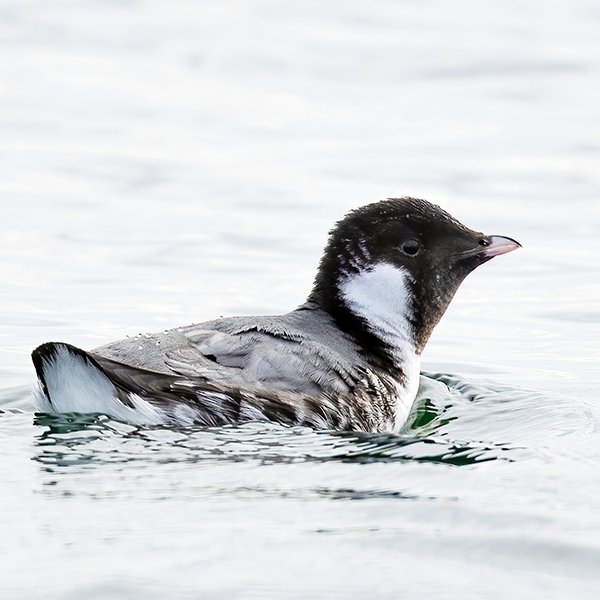Bird of the Month: Ancient Murrelet
Written by Andy McCormick
Andy McCormick, Volunteer and Former Board President of Eastside Audubon
Nearly half the world population of Ancient Murrelets breeds on Haida Gwaii off the coast of British Columbia. Many are winter residents along the Pacific Coast and in the eastern Strait of Juan de Fuca.
CHICKS HATCHED IN A BURROW AND RAISED AT SEA
The Ancient Murrelet is unique among the auks because it raises its young at sea. Most auks raise one chick, but the Ancient Murrelet raises two. Together the parents dig a burrow two to five feet long and at the end build a nest chamber lined with grasses and twigs. Murrelet chicks are not fed in the nest, but within one to three days of hatching a singing adult leads the chicks to water. For the next month or so the parents feed the chicks as they learn to forage on their own (Kaufman).
The diet for adults and chicks consists of small fish such as sand lance, herring, and smelt, and a mix of large zooplankton including krill. They forage on the open sea near the continental shelf, but at times they can feed close to shore where cold water upwellings bring food items to the surface.
The tongue-twisting genus name Synthlioboramphus is from the Greek sunthlibo meaning compress, and ramphos, a bill or beak. The reference is to the bird’s laterally compressed bill. The species epithet antiquus, Latin for ancient or old, refers to the gray feathers on the head in breeding plumage as a sign of aging (Holloway). The yellow bill of the Ancient Murrelet is short and stout with a black base (Alderfer).
Ancient Murrelet
Scientific Name: Synthlioboramphus antiquus
Length: 10”
Wingspan: 17”
Weight: 7oz (205g)
AOU Alpha Code: ANMU
THE NOCTURNAL SINGING MURRELET
Perhaps our most vocal alcid, the Ancient Murrelet has a daily pattern of singing. Beginning when the birds arrive back on the breeding grounds after dark, singing is performed while the birds perch in a tree, on a stump, or from some other raised position. Once one bird commences singing others in the colony join in and respond with counter singing. The songs consist of chirrups mixed with chips, long whistles, and short whistles which become stronger and more frequent on darker nights. Bright moonlight suppresses their singing. On most nights singing reaches a peak between two and four hours before dawn (Gaston and Shoji).
Ancient Murrelet singing is important for communication in the colony and at sea. “When family parties depart from the burrow there is a brief burst of Counter-calling between parents and chicks, with the parents giving a very explosive version of the Chirrup call and the chicks replying with a piercing wee-wee call” (Gaston and Shoji). Call recognition while on the ocean is an essential aid for reuniting parents and the chicks. Photos, videos, and vocalizations of these birds can be viewed and heard at the Macaulay Library.
STATUS AND DISTRIBUTION
The Ancient Murrelet is a wide-spread seabird of the North Pacific Ocean and breeds across the Pacific Rim from South Korea to the Aleutian Islands to Haida Gwaii (formerly the Queen Charlotte Islands) off British Columbia. Ancient Murrelets breeding on Haida Gwaii disperse in September and their whereabouts after that have not been confirmed. However, thousands of Ancient Murrelets gather in the Chukchi Sea during September and the birds may join those flocks. Movement south occurs in October when they disperse at sea beyond the Pacific Coast from British Columbia to Southern California (Gaston and Shoji).
The world population of Ancient Murrelets is estimated to be about one million birds. However, these numbers are declining due to predation on the breeding grounds by introduced species such as foxes, racoons, and rats which raid the nests. Conservation efforts currently focus on eradicating these predators. These efforts have been successful on some Aleutian Islands. However, eliminating racoons from the important breeding grounds on Haida Gwaii has so far had limited success, but may be the most urgent issue for conservation of these murrelets in British Columbia and probably world-wide (Gaston and Shoji).
Photo credit: Eric Ellingson
References available upon request from amccormick@eastsideaudubon.org



